Chokecherry
(Prunus virginiana)
Chokecherry flowers and leaves
What's in a name? Chokecherry, bitter-berry, Virginia bird cherry, or western chokecherry are all used to describe Prunus virginiana, a native, perennial, deciduous, woody plant in the rose family (Rosaceae). Prunus is Latin for plum or cherry tree.
This suckering, smooth-barked shrub grows to 20 feet tall with an irregular crown spreading from 10 to 20 feet when mature. Chokecherry grows in damp and fertile soil along mountain streams as well as in thickets on hillsides and canyon slopes.
Five-petaled flowers appear abundantly in showy, 3-6 inch racemes (elongated flower cluster) from May to June. Fragrant blossoms with an almond-like scent attract pollinating bees and flies. In late summer, pea-sized drupes (fleshy fruit around a hard stone) ripen to dark crimson/black “cherries.” Chokecherry is somewhat self-fertile, but fruit production increases when multiple shrubs are present.
Chokecherry fruit
Glossy dark green leaves have a grayish green underside. They are oblong, 2-5 inches long with finely serrated margins and an almost hair-like tip. Fall color changes to yellow/orange. Chokecherry tolerates a wide range of soil types and textures, preferring full sun or part shade.
Often planted for watershed protection, windbreaks, wildlife, and erosion control, Chokecherry spreads by seed or root rhizomes. Deep root systems grow along the the rhizomes which can extend beyond the drip zone, up to 35 feet from the base of the tree. In a landscaped area removing suckers controls unwanted spread.
Chokecherry is an important part of the diet of wild mammals, large and small. Browsing on young, immature trees can cause damage in a landscaped area, but the shrub is resilient. When other forage is scarce Chokecherry can be toxic to livestock if eaten in large quantities. New growth during spring and summer is the most toxic. By the time fruits mature the leaves are no longer toxic.
Ripe fruit is rich in antioxidants and, when sweetened, has been popular in jams and syrups for generations. Like many members of the Prunus genus, the seed contains hydrocyanic acid and is poisonous if eaten raw. Native Americans used dried Chokecherries in pemmican, a traditional food staple. Early settlers and local Indians had many medicinal uses for Chokecherry bark and roots, including sedatives, blood-fortifying tonics and appetite stimulants. Chokecherry tea was used to treat coughs, tuberculosis, malaria, stomachaches and intestinal worms.
Five species of butterflies, including tiger swallowtail, and 10 species of giant silk moths feed on the foliage of members of the genus Prunus. Additionally, it is susceptible to many of the same diseases and pests common to domestic cherry and plum varieties.
Chokecherry grows in the Dry Meadow Habitat in the North Idaho Native Plant Arboretum. Open to the public, Arboretum parking is at 611 S. Ella Ave. or on the street.
Learn more about Chokecherry on page 70 of the KNPS publication, Landscaping with Native Plants in the Idaho Panhandle, available at local bookstores and the Bonner County History Museum.
Native Plant Notes are created by the Kinnikinnick Native Plant Society. To learn more about KNPS and the North Idaho Native Plant Arboretum, explore www.nativeplantsociety.org.


